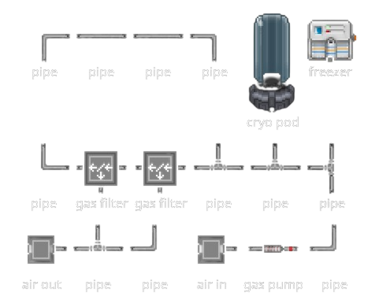Cryogenics
 Cryogenic Pods - The Fastest Way to Heal - By Nanotrasen
Cryogenic Pods - The Fastest Way to Heal - By Nanotrasen
One of the most powerful tools that medical has in its disposal is the cryogenic pods. These pods allow you to quickly heal all sorts of damage and bring people back to full health, IF you use them correctly.
Setting Up Cryogenics

Cryogenics requires a very low temperature in order to function. In most stations, this will already be set up for you. In others, you may need the assistance of both Engineering and Atmospherics in order to get a cryogenics room running.
If you need to set up the room:
- Gas pumps: Set to 103.25kpa as to not crush the patient.
- Freezer: Set to any temperature under 170k. It is common practice to set the as low as 100k for faster results.
- Gas Filter(s): Turned on to remove waste gas from the loop if treatment is long. Carbon Dioxide and Nitrous Oxide cover all patients you will encounter waste gas wise.
- Gas port: Wrench an air (oxygen or nitrogen depending on patient species works too) canister to the port if healing live patient.
Failure to correctly set up the cryogenic room can lead to DEATH.
Using the Pod
So, you have a patient who is dying, oh no! Let's help them out the best we can!
The patient body's temperature needs to be at most 213k for the cryogenic medicines to work. Insert the patient into the pod for the body to reach the appropriate temperature while you determine what chemical to use. You should take off the patient outwear to help speed up the chilling process.
Fill a beaker with whatever mix of chemical the patient needs. MOST of the cryogenic chemicals work if the patient is dead or alive. Your goal here is to get the damage low enough so you can defibrate them (>195) or fully heal them if you have enough chemicals.
Once your patient is healed, eject them out of the cryogenic pod. If they are still dead, defibrate them and continue care on a medical bed. A follow-up with Leporazine via a beaker in the pod or syringe is recommended for patient to get their body temperature back to normal.
| Name | Effect |
|---|---|
| ▮ Aloxadone | Heals 5.0 Heat Heals 5.0 Shock Heals 5.0 Cold Heals 2.0 Caustic when the body's temperature is below 213.0 |
| ▮ Cryoxadone | Increase blood levels. Heals 5 AIR when the body's temperature is at most 213k |
| ▮ Doxarubixadone | Heals 2 Cellular when the body's temperature is below 213.0 |
| ▮ Necrosol | Heals 2 Poison Heals 4 BRUTE Heals 5 BURN when the body's temperature is below 213.0 |
| ▮ Netinadone | Regenerates 10 seconds of rotting when the mob has component type RibcageOpen when the body's temperature is below 150.0 K when the mob is Dead. |
| ▮ Opporozidone | Regenerates 30 seconds of rotting when the body's temperature is below 150.0 K when the mob is Dead |
| ▮ Stelloxadone | Heals 6 Poison Heals 3 Radiation Deals 1 Cellular Deals 3 BRUTE when the body's temperature is below 213.0 |
| ▮ Traumoxadone | Heals 2 Blunt Heals 2 Piercing Heals 2 Slash when the body's temperature is below 213.0 |
| ▮ Trinoxadone | Heals 1.33 BRUTE Heals 1.5 BURN Heals 2 Poison Heals 2 Radiation when body's temperature is at most 213k and mob is critical or alive |
Pyrogenics
Works inversely to cryogenics with the same principles. Instead of turning the freezer to a temperature below 170k, set the temperature to 350k. The patient body temperature must be at least 337.3k for pyrogenic chemicals to work.
| Name | Effect |
|---|---|
| ▮ Ardthyrnkole | Heals 5 Cold Heals 3 Heat Heals 3 Shock when the body's temperature is above 343.3 |
| ▮ Natusixadone | Heals 4 Cellular Heals 3 Heat when the body's temperature is above 343.3 K |
| ▮ Pyroxadone | Heals 3 Heat Heals 6 AIR Heals 4 BRUTE Heals 6 BURN Heals 4 TOXIN when the body's temperature is above 337.3 |
Any heat damage cause will likely be healed during a pyrogenic treatment.